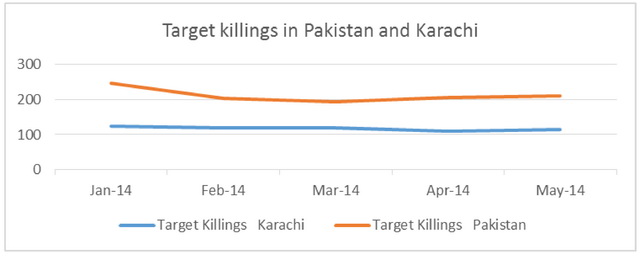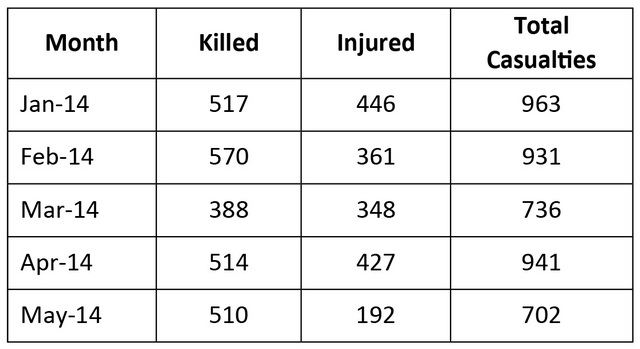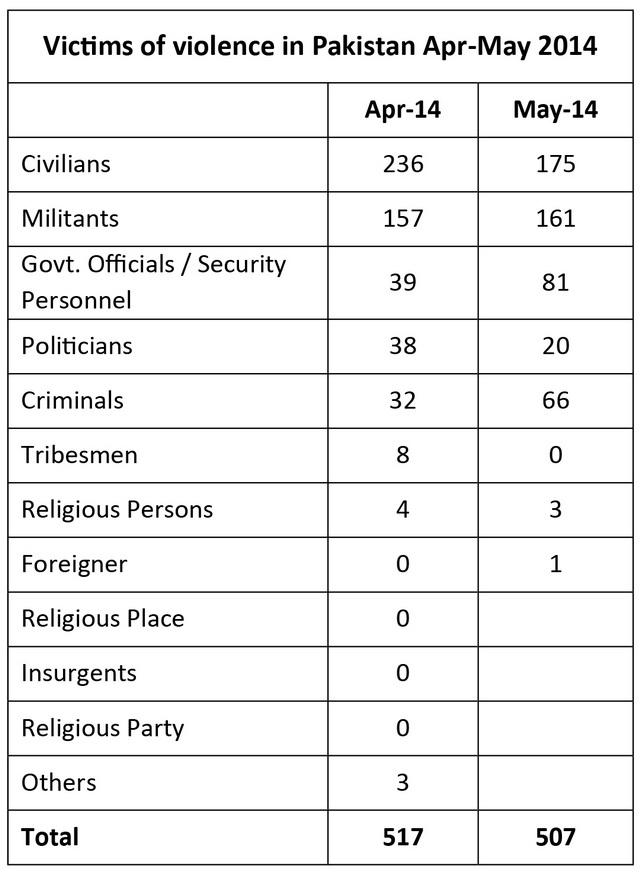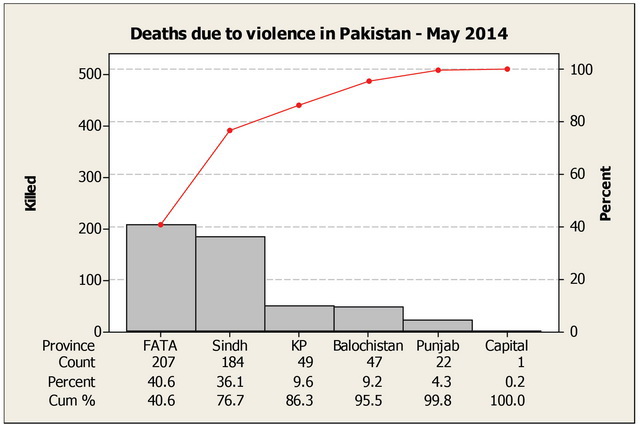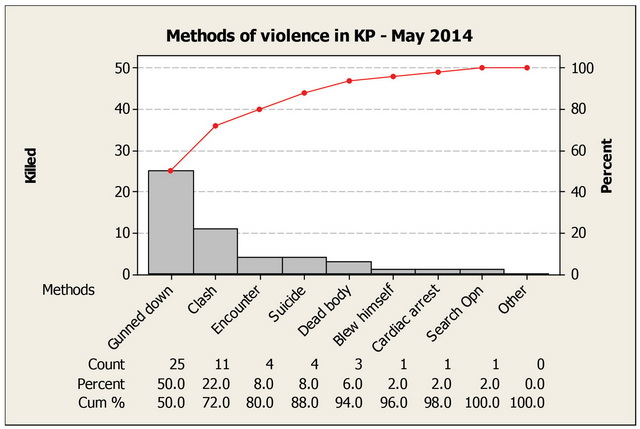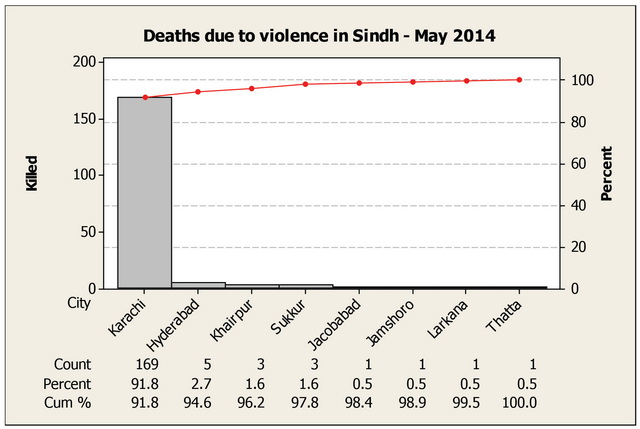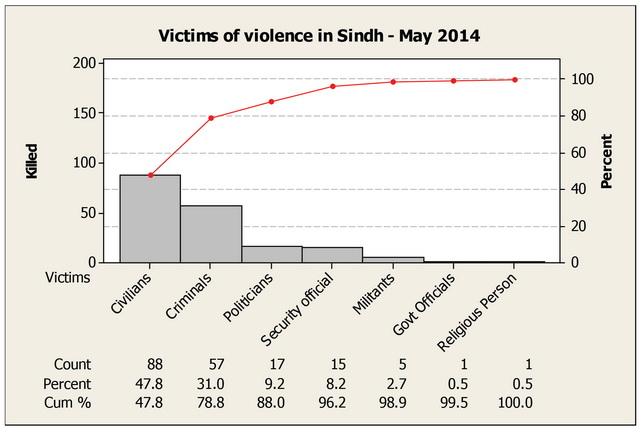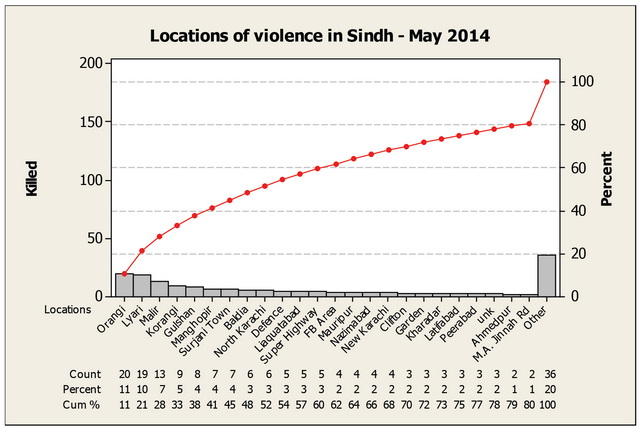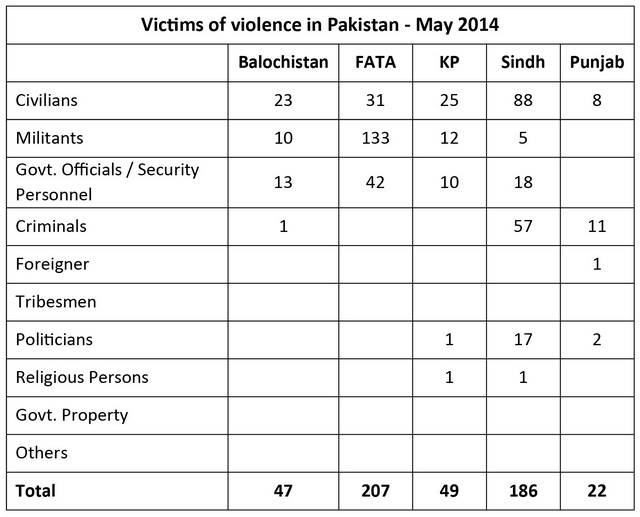There was a significant drop of 50 % in mortalities in May 2014, as compared to the average death toll during this year mainly due to respite in terrorists acts. Sectarian killings declined in May, but places of worship of both Muslims and non-Muslims came under attack in the country. Though, violence continued unabated in Pakistan, but with changed indicators. The in-fighting between the rival factions Saad Khan alias Sajna and Shehryar Mehsud of Tehrik-i-Taliban (TTP) halted the government –TTP talks and recorded the highest number of deaths from Federally Administered Tribal Region (FATA) in one and a half year. This also resulted in the much awaited retaliatory military operation in North Waziristan.
Target killings continued to take its toll in Karachi and other parts of the country with figures remaining much the same as in previous months. The on-going operation in Karachi did result in some relief; however, new crimes and new perpetrators have surfaced claiming lives and keeping the death rate unchanged (Refer to graph 1).
Graph 1: Target killings in Pakistan and Karachi
All these events and other facts reported in the national newspapers are collected to make this report as informative and factual as possible. As expected, errors and omissions, as always are a possibility in all statistical works including this one. However, such mistakes do not grossly affect the basic objective of this report. This report mainly covers the following topics:
Deaths from violence in the country during May 2014
Affected Districts
Deaths from violence in provinces of Pakistan
Victims of violence in Balochistan
Means of violence in Balochistan
Victims of violence in FATA
Means of violence in FATA
Victims of violence in KPK:
Means of violence in KPK
Victims of violence in Punjab
Means of violence in Punjab
Victims of violence in Sindh
Means of violence in Sindh
Summary of violence in Pakistan
CRSS welcomes and appreciates comments and feedback from readers on the report.
Report prepared by:
Mohammad Nafees
Senior Research Fellow
Center for Research and Security Studies
NOTE: Readers can approach CRSS for source of any information included in the report. Please send your request to: [mail@crss.pk]
OVERVIEW
Deaths from violence in the country:
In May, violence claimed 702 causalities (510 dead and 192 injured) compared to 941 in April, recording a drop of 20 %. (Refer to table 1). One of the reasons for the drop in fatalities was the number of criminals killed i.e. 77 in May from 32 in April, an increase of 100%. Another reason was the 100% rise in the death toll of government and security officials following the military operation in FATA region (Refer to table 2). FATA recorded the highest number of mortalities in May (Refer to graph 3) due to the in-fighting between the two TTP factions, and the retaliatory military operation in North Waziristan killing nearly 130 militants.
Table 1: Casualties of violence – Jan 2014 – May 2014
Table 2: Death due to violence April – May 2014
Graph 2: Deaths from violence in provinces – Jan – May 2014
Target killings claimed most lives in May while anti- terrorist operations carried out by the security agencies also took many lives. (Refer to graph 3).
Graph 3: Nature of violence in Pakistan – May 2014
Districts affected by violence:
Karachi ranked at the top among the most affected district in May, followed by North Waziristan, Mohmand Agency, Khyber Agency, Bajaur Agency, and Panjgur (Refer graph 4). This is for the first time that Panjgur in Balochistan has been mentioned following operations against insurgents that killed ten (10) separatists belonging to Lashkar-e-Balochistan and Baloch Liberation Front and murders of a school teacher and five members of his family. According to the reports, gunship helicopter and heavy weaponry[1] was used in the operation.
Graph 4: Deaths from violence in city districts
Deaths from violence in provinces:
A review of violence in provinces reveals that the nature of violence and its victims vary in each province. The report will analyze the grounds for these differences so as to understand the challenges and problems faced by the government in each of the provinces.
Balochistan: Victims of violence
Twelve districts of Balochistan with Panjgur at the top experienced the highest number of acts of violence with 16 dead. The districts among others included Khuzdar, Kech, Jhal Magsi, Quetta, Washuk. (Refer graph 5).
Graph 5: Deaths from violence in districts of Balochistan – May 2014
Target killings claimed 21 lives, militancy (armed attacks and bomb explosions) 15, and retaliatory security operations killed 12 militants and one criminal. On May 6, 2014, Frontier Constabulary carried out a security operation against militant hideouts in the mountains of Panjgur with the help of gunship helicopters[2] killing ten separatists. In retaliation the militants attacked and killed 12 security personnel and injured 19. They also killed a school teacher and his family (6) because the BLF suspected him of being an informer[3]. In May, Balochistan lost 23 civilians, 12 security officials, 10 militants, one criminal, and one government official. Two Pakistanis were also killed when attempting to enter Iran illegally.
Means of violence:
The most common means of violence: shot at, air raid, armed attacks, bomb explosions, abduction and dumping of dead bodies, and landmines.
Graph 6: Nature of violence in Balochistan – May 2014
FATA: Victims of violence
All the tribal agencies in FATA suffered violence related fatalities with North Waziristan claiming the highest number of 125 dead, followed by Mohmand Agency (28), Bajaur Agency (21), Khyber Agency (19), South Waziristan (8), and Orakzai (5). According to the reports Khyber and Bajaur Agencies have been cleared of militants but news of acts of terror continue to trickle in from here. In FATA, militants lost 133 people and security officials 42 personnel while civilian victims numbered 31. Nearly one fourth of the militants were killed in May. The in-fighting between the TTP rival groups also added to the number of dead and injured both among militants and security personnel.
Means of violence:
The means used to carry out violence in FATA were fatal and destructive. Army used fighter jets and gunship helicopters in its operation in North Waziristan. The militants used improvised explosive devices (IEDs), armed attacks, bomb explosions, landmines for maximum results. (Refer graph 7).
Graph 7: Means of violence in FATA – May 2014
Victims of violence in KPK:
In Khyber Pakhtunkhwa (KPK) 49 people died in May. District-wise, Peshawar topped the list with (11), Swat (9), Bannu (6), Dera Ismail Khan (6), Charsadda (5), Hangu (5), Mardan (4), Swabi (2), and Kohat (1). (Refer table 3).
Table 3: Victims of violence in KPK – May 2014
Means of violence in KPK:
In KPK most of the victims were shot at, or killed in armed clashes and encounters between the militants and security forces, suicide attacks, abduction and dumping of dead bodies, and others (Refer graph 8)
Graph 8: Means of violence in KPK – May 2014
Victims of violence in Punjab:
Punjab is relatively safe as far as militancy and terrorism is concerned. In May, however, there were some incidents of terrorism. The number of people who died in Punjab was 22 with 11 being criminals killed in police encounters. The civilians included laborers, a lawyer, a doctor, political activists and a school principal. The killings took place in Faisalabad (9), Rawalpindi (3), Renala Khurd (3), Lahore (3), Jaranwala (2), Multan (1), and Rahim Yar Khan (1).
Means of violence:
In most cases the people were shot dead, however, there were incidents of bomb explosions in which people were mostly injured. The reported incidents are: On May 16, a bomb exploded in the parking lot of a restaurant injuring 15 people in Rawalpindi. On May 19, in Rajanpur the Khushhal Khan Khattak Express narrowly escaped a blast that blew up the railway track in Rojhan Mazari Tehsil.
Sindh: Victims of violence:
In Sindh, of the 184 people killed, 169 belonged to Karachi. The rest 15 people were killed in other districts of Sindh. (Refer graph 9), Hyderabad, Thatta and Jamshoro and its adjoining areas claimed seven of the 15 victims.
The percentage of victims killed was almost 50% civilians, 30% criminals and militants, 10% political activists, and 10% security and government officials (Refer graph 10). The most affected areas in Karachi were Orangi, Lyari, Malir, Korangi, Gulshan, Manghopir, Surjani town, Baldia and etc (Refer graph 11).
Graph 9: Deaths due to violence in Sindh – May 2014
Graph 10: Victims of violence in Sindh – May 2014
Graph 11: Locations of violence in Sindh – May 2014
Means of violence:
The means used in cases of target killing and police encounters were guns, and abduction and dumping of dead bodies. There were sporadic events of armed attacks by the militants in Karachi.
Summary of violence in Pakistan:
It is evident from the report that militancy is fast spreading in other parts of the country, except Punjab. On the other hand, criminal elements have become active in Sindh and Punjab (Refer table 2). The table also demonstrates that as compared to security agencies and criminals, civilians are worse off in Sindh, KPK, Balochistan and Punjab except in FATA.
Table 4: Victims of violence in provinces of Pakistan – May 2014
Sectarian violence in Pakistan:
In May, sectarian violence in Pakistan left 26 persons dead; Sindh (20), Punjab (4), FATA (1) and KPK (1). There was a drop of almost 50% from April that recorded 40 victims. The breakdown of victims is as follows; Shia (14), Sunni (10), and Ahmedi (2).
Professions followed by some of the victims are as follows:
|
2 |
|
2 |
|
2 |
|
1 |
|
1 |
|
1 |
|
1 |
|
1 |
|
1 |
|
1 |
|
1 |
In May, six holy places were desecrated in Sindh and KPK. Following are the numbers of holy places desecrated and its locations:
|
2 |
|
1 |
|
3 |
Conclusion:
Militancy to insurgency and sectarian hatred to political rivalries, are all on the rise in the country and the law enforcement agencies are finding it difficult to face up to the challenges posed by these extremist and criminal activities. The deteriorating situation requires other stakeholders to play their part in combating mainly, the mindset that is pushing people to take the law into their own hands.
Security operations in FATA, Balochistan, and Karachi did eliminate or apprehend some criminal elements but it couldn’t restrict their resurgence in new forms and at different places. For example, there was a drop in death rate in Quetta, but Panjgur suddenly experienced a spate of violence killing 16 people. In Sindh, while Karachi recorded highest number of deaths, but other districts of Sindh also saw an upsurge in killings as compared to the beginning of the year i.e. from four (4) to 16 from January to May 2014. Since April, Karachi is also experiencing a large number of robberies and in May 42 robbers were reportedly killed during security operations in Karachi. The rapidly worsening situation obtaining in the country needs visionary and effective response from the government and the army and other stakeholders.


